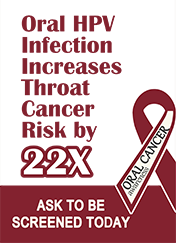Common Procedures

Regular Exams and Cleanings
Regular exams are an important part of maintaining your oral health. During your regular exam, Dr. Blancaflor will:
- Check for any problems that you may not see or feel
- Look for cavities or any other signs of tooth decay
- Inspect your teeth and gums for gingivitis and signs of periodontal disease
- Provide a thorough teeth cleaning
Your regular exam can take anywhere from 20 minutes to 40 minutes. Each regular exam includes a detailed teeth cleaning, in which Dr. Blancaflor will clean, polish, and rinse your teeth to remove any tartar and plaque that has built up on the tooth's surface.
Visiting our office every six months gives you the chance to talk with Dr. Blancaflor and receive answers for any questions you may have about your oral health. Regular exams are offered by appointment only, so please contact our practice today to schedule your next dental exam and teeth cleaning.
HPV Testing
We are excited to announce that we now test for oral HPV during the general oral cancer screening.
In the past three decades, the oral cancer incidence has been rising steadily, primarily due to oral HPV infections. The make-up of oral cancer has been changing with traditional risk factors such as tobacco/alcohol abuse declining while HPV-related cancer has been rising. In the US, HPV-related oral cancers have increased 225% over the past 15 years.
HPV-induced cancers tend to be located in the tonsillar regions and the pharynx where it is difficult to see visually. This new swish test can detect the virus without any signs and symptoms. This test will tell us if you would benefit from extra monitoring.
We will ask you to swish with Scope for 30 seconds. The sample will then be analyzed in a certified lab and within two weeks you will have the result. Since the virus can be dormant and then reactivate later in life, this screening will be a regular part of our oral cancer screening. If the result comes back negative, we will suggest screening again in twelve months. If the test comes back positive, it does not mean you have cancer but that you may be at higher risk.
The virus only causes cancer if the infection is persistent. By screening again in 6 months we can tell if it is clearing or if you would benefit from further screening. It can take up to 2 years for the virus to become persistent and even longer before becoming cancer. It leaves time to intervene and potentially prevent it from becoming cancer.
We will submit the screening to your insurance. Some plans are quick to cover the cost while others still don’t have this part of their plans.
It will be our pleasure to answer any questions you may have and please know that our entire staff is well versed on the subject of HPV related oral cancer.
Here is a link to a recent CBS clip talking about HPV related oral cancer.
To learn more about HPV, go to the Fidalab website for more information.

Bonding
Bonding is a conservative way to repair slightly chipped, discolored, or crooked teeth. During dental bonding, a white filling is placed onto your tooth to improve its appearance. The filling "bonds" with your teeth, and because it comes in a variety of tooth-colored shades it closely matches the appearance of your natural teeth.
Tooth bonding can also be used for teeth fillings instead of amalgam fillings. Many patients prefer bonding fillings because the white color is much less noticeable than the silver amalgam fillings. Bonding fillings can be used on front and back teeth depending on the location and extent of tooth decay.
Bonding is less expensive than other cosmetic treatments and usually can be completed in one visit to our office. However, bonding can stain and is easier to break than other cosmetic treatments such as porcelain veneers. If it does break or chip, tell Dr. Blancaflor. The bonding can generally be easily patched or repaired in one visit.

Bridges
A bridge may be used to replace missing teeth, help maintain the shape of your face, and alleviate stress in your bite.
A bridge replaces missing teeth with artificial teeth, looks great, and literally bridges the gap where one or more teeth may have been. Your bridge can be made from gold, alloys, porcelain, or a combination of these materials and is bonded onto surrounding teeth for support.
The success of any bridge depends on its foundation — the other teeth, gums, or bone to which it is attached. Therefore, it's very important to keep your existing teeth, gums, and jaw healthy and strong.

Crowns
Crowns are a cosmetic restoration used to improve your tooth's shape or to strengthen a tooth. Crowns are most often used for teeth that are broken, worn, or have portions destroyed by tooth decay.
Crowns are "caps" cemented onto an existing tooth which fully cover the portion of your tooth above the gum line. In effect, the crown becomes your tooth's new outer surface. Crowns can be made of porcelain, metal, or both. Porcelain crowns are most often preferred because they mimic the translucency of natural teeth and are very strong.
Crowns are often preferable to silver amalgam fillings. Unlike fillings which apply metal directly into your mouth, a crown is fabricated away from your mouth. Your crown is created in a lab from your unique tooth impression which allows a dental laboratory technician to examine all aspects of your bite and jaw movements. Your crown is then sculpted just for you so that your bite and jaw movements function normally once the crown is placed.

Extractions
There are times when it is necessary to remove a tooth. Sometimes a baby tooth has misshapen or long roots that prevent it from falling out as it should, and the tooth must be removed to make way for the permanent tooth to erupt. At other times, a tooth may have so much decay that it puts the surrounding teeth and jaw at risk of decay, so Dr. Blancaflor may recommend removal and replacement with a bridge or implant. Infection, orthodontic correction, or problems with a wisdom tooth can also require removal of a tooth.
When it is determined that a tooth needs to be removed, Dr. Blancaflor may extract the tooth during a regular checkup or may request another visit for this procedure. The root of each tooth is encased within your jawbone in a "tooth socket," and your tooth is held in that socket by a ligament. In order to extract a tooth, Dr. Blancaflor must expand the socket and separate the tooth from the ligament holding it in place. While this procedure is typically very quick, it is important to share any concerns or preferences for sedation with us.
Once a tooth has been removed, neighboring teeth may shift causing problems with chewing or with your jaw joint function. To avoid these complications, Dr. Blancaflor may recommend that you replace the extracted tooth.

Fillings
Traditional dental restoratives (fillings) include gold, porcelain, and composite/amalgam. The strength and durability of traditional dental materials continue to make them useful for situations where restored teeth must withstand extreme forces that result from chewing, such as in the back of the mouth.
Newer dental fillings include ceramic and plastic compounds that mimic the appearance of natural teeth. These compounds, often called composite resins, are usually used on the front teeth where a natural appearance is important. They can be used on the back teeth as well depending on the location and extent of the tooth decay. Composite resins are usually more costly than the older silver amalgam fillings.
What's Right for Me?
Several factors influence the performance, durability, longevity and expense of dental restorations:
- The components used in the filling material
- The amount of tooth structure remaining
- Where and how the filling is placed
- The chewing load that the tooth will have to bear
- The length and number of visits needed to prepare and adjust the restored tooth
The ultimate decision about what to use is best determined in consultation with your doctor. Before your treatment begins, discuss the options with Dr. Blancaflor. To help you prepare for this discussion it is helpful to understand the two basic types of dental fillings: direct and indirect.
- Direct fillings are fillings placed immediately into a prepared cavity in a single visit. They include dental amalgam, glass ionomers, resin ionomers, and composite (resin) fillings. Dr. Blancaflor prepares the tooth, places the filling, and adjusts it during one appointment.
- Indirect fillings generally require two or more visits. They include inlays, onlays, veneers, crowns, and bridges fabricated with gold, base metal alloys, ceramics, or composites. During the first visit, Dr. Blancaflor prepares the tooth and makes an impression of the area to be restored. Dr. Blancaflor then places a temporary covering over the prepared tooth. The impression is sent to a dental laboratory which creates the dental restoration. At the next appointment, Dr. Blancaflor cements the restoration into the prepared cavity and adjusts it as needed.
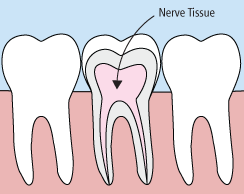
Root Canal (Endodontic) Treatment
In the past, if you had a tooth with a diseased nerve, you'd probably lose that tooth. Today, with a special dental procedure called root canal treatment, you may save that tooth.
Inside each tooth is both the pulp and the nerve. The nerve is the vestige of the tissue that originally formed the tooth. Once the tooth has been in the mouth for a time, the functioning of the nerve is no longer necessary.
When a tooth is cracked or has a deep cavity, bacteria can enter the pulp. Germs can cause an infection inside the tooth. Left without treatment, pus builds up at the root tip in the jawbone, forming a "pus-pocket" called an abscess. An abscess can cause the pulp tissue to die. When the infected pulp is not removed, pain and swelling can result. Certain by-products of the infection can injure your jawbones and your overall health. Without treatment, your tooth may have to be removed.
Treatment often involves from one to three visits. During treatment, your general dentist or endodontist (a dentist who specializes in problems of the pulp) removes the diseased pulp. Next, the pulp chamber and root canal(s) of the tooth are cleaned and sealed. Often posterior teeth that have endodontic treatment should have a cast crown placed in order to strengthen the remaining structure. Then, as long as you continue to care for your teeth and gums with regular brushing, flossing, and checkups so that the root(s) of the restored tooth are nourished by the surrounding tissues, your restored tooth can last a lifetime.
Most of the time a root canal is a relatively simple procedure with little or no discomfort, involving one to three visits. Best of all, it can save your tooth and your smile!

Sealants
Sometimes brushing is not enough. Everyone has hard-to-reach spots in their mouth and brushing doesn't always fully clean those difficult places. When that happens, you are at risk of tooth decay. Using sealants on your teeth gives you an extra line of defense against tooth decay.
Dental sealant is a plastic resin that bonds to the deep grooves in your tooth's chewing surface. When sealing a tooth, the grooves of your teeth are filled and the tooth surface becomes smoother — and less likely to harbor plaque. With sealants, tooth brushing becomes easier and more effective against tooth decay.
Sealants are usually applied to children's teeth as a preventive measure during the years of most likely tooth decay. However, adults' teeth can also be sealed. It is more common to seal "permanent" teeth rather than "baby" teeth, but every person has unique needs. Dr. Blancaflor will recommend sealants on a case-by-case basis.
Sealants generally last from three to five years. However, it is fairly common to see adults with sealants still intact from their childhood. A dental sealant only provides protection when it is fully intact so if your sealant comes off you must let your dentist know.

Veneers
There's no reason to put up with gaps in your teeth or with teeth that are stained, discolored, badly shaped, chipped, or crooked. Today, a veneer placed on top of your teeth can correct nature's mistake or the results of an injury and help you have a beautiful smile. Veneers are a highly popular solution among dental patients because of their lifelike tooth appearance.
Veneers are thin, custom-made shells crafted of tooth-colored materials (such as porcelain) designed to cover the front side of your teeth. To prepare for veneers, Dr. Blancaflor will create a unique model of your teeth. This model is sent to the dental technician to create your veneers. Before placing your new veneer, Dr. Blancaflor will remove a small amount of your tooth to make room for the veneer.
When placed, you'll be pleased to see that veneers look like your natural teeth and even resist staining. Though veneers are stain resistant, your doctor may recommend that you avoid coffee, tea, red wine, and tobacco to maintain the beauty of your veneer.
Implants
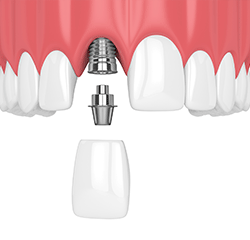
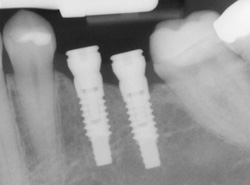
If you have missing teeth, it is crucial to replace them. Without all your teeth, chewing and eating can destabilize your bite and cause you discomfort. When teeth are missing, your mouth can shift and even cause your face to look older. Implants are a great way to replace your missing teeth and, if properly maintained, can last a lifetime!
An implant is a new tooth made of metal and porcelain that looks just like your natural tooth. It's composed of two main parts: One is the titanium implant body that takes the place of the missing root, and the second part is the tooth-colored crown that is cemented on top of the implant. With periodontal treatment, you can smile confidently knowing that no one will ever suspect you have a replacement tooth.
In addition to tooth replacement, implants may be used to anchor dentures, especially lower dentures that tend to shift when you talk or chew. For patients with removable partial dentures, implants can replace missing teeth so that you have a more natural looking smile.
ClearCorrect™
Show off your smile.™

ClearCorrect invisible braces are the clear and simple way to straighten your teeth so you can show off your smile with confidence! Looking for an alternative to metal braces? ClearCorrect is the clear and simple choice for patients of all ages. There are no wires or brackets; just clear, convenient comfort that gives you every reason to smile.

Effortless Convenience
With ClearCorrect, achieving your ideal smile is easy and effortless. Plus, since your clear aligners are removable, you can take them out to brush, floss, and eat your favorite foods. ClearCorrect fits your life and daily routine as perfectly as it fits your teeth, so you don't need to change a thing.
Out of Sight, Out of Mind
Unlike traditional metal braces, you can show off your smile while you straighten your teeth. You'll be surprised at how quickly you'll forget you're wearing your ClearCorrect aligners, and they're so clear that no one else will notice you're wearing them either
How ClearCorrect Works
After you and your doctor decide that ClearCorrect is the right treatment option to fit your unique goals and needs, you'll send your records, X-rays, and impressions to ClearCorrect. Next, working with your doctor every step of the way, ClearCorrect maps out a customized treatment plan of gradual adjustments that take your teeth from where they are currently to where you want them to be. You'll wear each set of aligners for a specific amount of time as your teeth gently adjust and align to your ideal smile. You'll visit your doctor periodically for checkups to monitor your progress until you eventually have the straight smile you've always wanted.
The Choice is Clear!
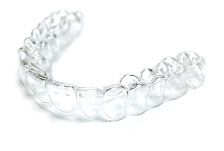
- Clear, custom-made, removable aligners that incrementally adjust teeth
- Superior clarity
- Smooth surface finish withstands clouding from wear
- Easily removable
- No interruption to eating or routine brushing and flossing
- Minimally invasive
Philips Zoom Whitening System

You deserve a bright, confident smile. Professional, in-office teeth whitening with Philips Zoom is safe, simple, and one of the fastest ways to improve the beauty of your smile. Plus, Philips Zoom is championed by dentists and patients as a pain-free, easy process.
Zoom WhiteSpeed Light-Activated Whitening System
The Zoom Chairside Light-Activated Gel greatly accelerates and enhances the whitening process, and delivers the dramatic results you will love. Along with the all-new Whitening LED Accelerator, your teeth can become up to eight shades lighter in just 45 minutes!
The gel and light work together gently to break up the stains on your teeth, while leaving the structure of your teeth unchanged. After just three 15-minute applications in one hour, you rinse and the treatment is complete, leaving you with a brighter, whiter smile.
Is Philips Zoom right for you?
Almost anyone can benefit from teeth whitening, though the treatment may not be as effective for some as it is for others. Zoom achieves the greatest success in treating yellow staining from aging, tobacco, dark cola, tea, coffee, or red wine. If your teeth have gray shading from tetracycline or other chemicals, you may still see improved results, though they may be less dramatic. Your dentist will be able to determine the ideal level of whitening for your individual smile during your personalized shade assessment.
A beautiful, sparkling smile can give you a whole new outlook on life. Contact us today to schedule an appointment for Philips Zoom whitening!
Dental Laser Technology
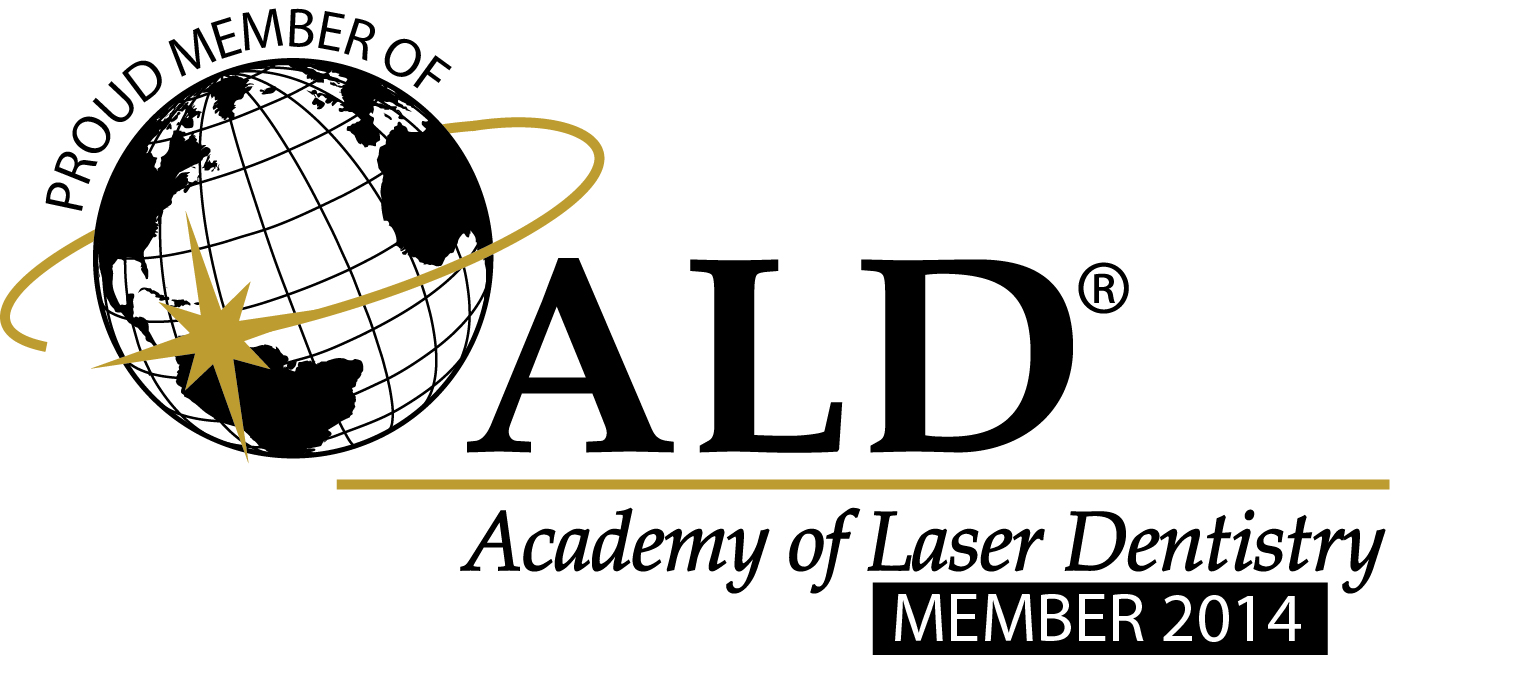
What are dental lasers?
Dental lasers are used for a variety of treatment procedures. Your dentist knows which types of care are more patient friendly with a laser than with alternative traditional methods. The dentists using lasers have devoted training time and expense to be able to bring you the many advantages of this exciting new technology.
Depending on your treatment needs, your dentist may use the laser for a long period of time or possibly only for brief moments. However, even those procedures that require only a short period of laser usage benefit from the advantages of laser therapy. With laser surgery, there is a reduced need for local anesthesia, bleeding is minimized, swelling is controlled, and there is usually little, if any, postoperative discomfort.
What is the laser experience like?
Dental lasers are a family of instruments. Some lasers are used for surgery, some to cure restorative materials and enhance tooth bleaching, and others to remove tooth structure for elimination of disease and restoration – different lasers for different procedures. All lasers require eye protection. Safety glasses with special lenses will be provided. Family and guests in the dental operatory at the time of your laser treatment may also be asked to wear protective eyeglasses.
Lasers do not make whining sounds or other annoying noises. You may experience the sound of a rush of air, since air suction is often used to keep the area cool and cleaner. You should be able to relax and be comfortable while the dental laser is in use.

